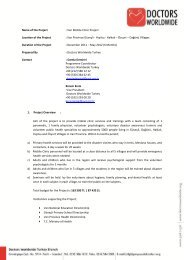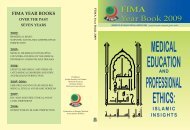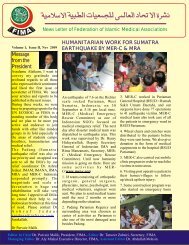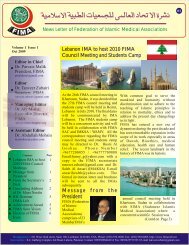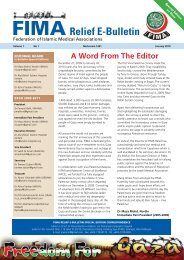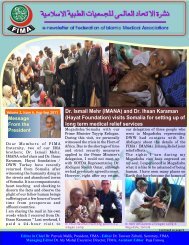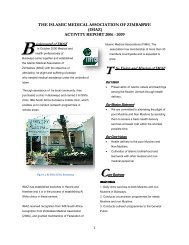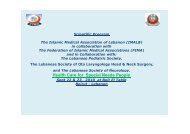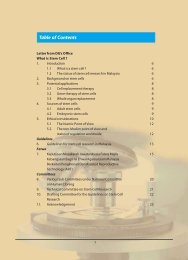FIMA Year Book 2010-2011 - Federation of Islamic Medical ...
FIMA Year Book 2010-2011 - Federation of Islamic Medical ...
FIMA Year Book 2010-2011 - Federation of Islamic Medical ...
Create successful ePaper yourself
Turn your PDF publications into a flip-book with our unique Google optimized e-Paper software.
VIVA PALESTINA 5<br />
Brief History <strong>of</strong> Palestine and the Invasion <strong>of</strong><br />
Gaza:<br />
Historic Palestine is located in the Middle East, in<br />
a region bordering Lebanon, Syria, Jordan, Egypt<br />
and the Mediterranean Sea. It was part <strong>of</strong> the<br />
Ottoman caliphate until 1918 when it was<br />
occupied by Britain until 1948. The Balfour<br />
Declaration <strong>of</strong> 1917 was the antecedent to the<br />
unilateral establishment <strong>of</strong> the state <strong>of</strong> Israel in<br />
1948. By 1949, the Nakba (catastrophe) had<br />
resulted in the expulsion <strong>of</strong> two thirds <strong>of</strong> the<br />
indigenous Palestinians and the Israeli occupation<br />
<strong>of</strong> 78 per cent <strong>of</strong> the land 1 .<br />
Gaza is a narrow coastal strip along the<br />
Mediterranean Sea, in the south <strong>of</strong> Palestine. It is<br />
about 41 km long and between 6-12 km wide, with<br />
a total area <strong>of</strong> 360 square km. The population is<br />
about 1,535,120 people (mid <strong>2010</strong> figures) making<br />
Gaza one <strong>of</strong> the most densely populated areas in<br />
the world.<br />
The West Bank and Gaza Strip have been under<br />
an illegal Israeli military rule since they were<br />
occupied in the 1967 war. Although Israel<br />
withdrew from Gaza in 2005 it has since tightened<br />
its grip on the population, exercising absolute<br />
control <strong>of</strong> who and what goes in and out <strong>of</strong> the<br />
Strip by land, sea and air.<br />
From 27 December 2008 to 19 January 2009,<br />
Israel bombarded the Gaza Strip. The 22 days <strong>of</strong><br />
invasion and onslaught left 1,417 dead, <strong>of</strong> whom<br />
926 were civilians including 116 women and 313<br />
children 2 . Among the 5,380 injured were 1,872<br />
children and 800 women. An estimated 21,000<br />
homes were destroyed and approximately 50,000<br />
displaced from their homes. 15 <strong>of</strong> Gaza’s 27<br />
hospitals and 43 <strong>of</strong> its 110 primary health care<br />
centers and large numbers <strong>of</strong> places <strong>of</strong> worship<br />
(mosques), and educational institutions (including<br />
schools) were targeted or destroyed.Over 30<br />
hectares <strong>of</strong> green houses, nearly all <strong>of</strong> its 10,000<br />
family farms and 800 water wells were damaged<br />
resulting in ½ million without running water, 1<br />
million without electricity and resulting in acute<br />
food shortages 3 .<br />
Summary <strong>of</strong> the Impact <strong>of</strong> the Blockade and<br />
Military Operations on Gaza:<br />
Gazans have been living under Israeli occupation<br />
for decades enduring the restrictions implemented<br />
by the occupying power. This was compounded by<br />
the military invasion, further restricting access to<br />
essential items vital for “normal existence”. The<br />
people <strong>of</strong> Gaza have become destitutes in their<br />
homeland, more so the women and children. The<br />
current situation has been described as a crisis <strong>of</strong><br />
human dignity 4 .<br />
Even prior to Operation Cast Lead, the code name<br />
for the Israeli war on Gaza 2008-2009, the Gaza<br />
economy was already in dire straits. The blockade<br />
restricted or denied entry to a range <strong>of</strong> items, fuel<br />
and diesel necessary for factories, businesses and<br />
agricultural activities to function. The net result<br />
was a stalled economy, with many businesses,<br />
factories and farms either closed or operating at<br />
reduced capacity.<br />
In 2007, 79% <strong>of</strong> households lived below the<br />
<strong>of</strong>ficial poverty line (USD 4 per capita/day) and<br />
some 70% below the deep poverty line (USD 3<br />
per capita/day). These were expected to increase<br />
by the end <strong>of</strong> 2008 – even before the Israeli<br />
military operations. The agricultural sector had<br />
traditionally absorbed unemployed workers from<br />
other sectors. It could no longer fulfill this role<br />
due to the lack <strong>of</strong> fertilizers, pesticides,<br />
machinery, spare parts and access to foreign<br />
markets imposed by the siege.<br />
Fishing that provided direct employment to some<br />
3,000 people was also affected. Many boats and<br />
some fishermen were directly hit. Fishing<br />
activities had already been affected when Israel<br />
reduced the fishing limit from six to only three<br />
nautical miles.<br />
<strong>FIMA</strong> <strong>Year</strong><strong>Book</strong> <strong>2010</strong>-<strong>2011</strong> 120




